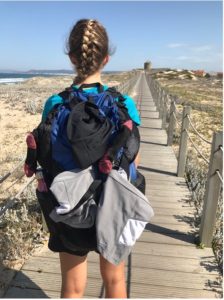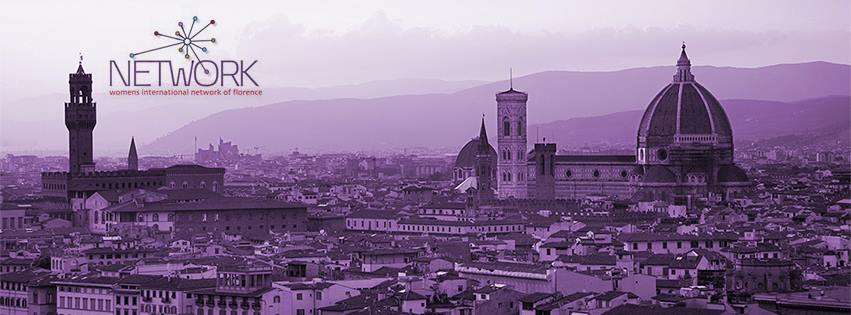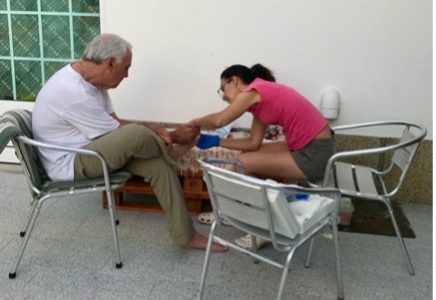Volunteer In The World – Blog 14 March 2022 Volunteer: Amanda
My first Camino de Santiago, along the Portuguese Coastal Way El Camino de Santiago de Compostela
Today, thousands of people from all over the world walk the Camino de Santiago every year, for all different reasons. Some are motivated by spiritual or
religious reasons. Others do it to take care of their physical or
mental health and well-being, and still others to feel a
connection with nature. However, the “Way of Saint James” was traditionally a religious pilgrimage: it dates back to the 9th Century, when pilgrims would walk from all across Europe and make the long journey to the Cathedral of Santiago de Compostela, where the body of Sant James the Apostle is buried.
The route was declared a UNESCO World Heritage Site in 1993. It is actually a network of routes which all have different starting points and cross various European countries. The traditional and most popular one is the Camino Frances, other examples are the Camino del Norte and the Camino Primitivo. My Aunt Laura and I, Amanda, walked the Camino Portugués Coastal Way in September 2019!
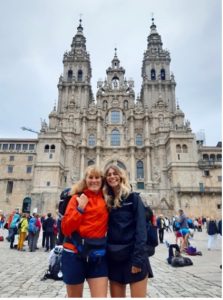
Step by step, km after km, day by day, rain or shine
We flew from Italy to Portugal, arriving in Porto, where we received our pilgrim passport, Credencial del Peregrino and spent our first night there in the Albergue de Peregrinos hostel. The next morning, we started our Camino! It took us 14 days to reach Santiago, covering approx. 300km.
We followed the sea while walking on wooden boardwalks over the sand
dunes, along the rocky Atlantic coastline. The route also brought us inland through the countryside and parts of eucalyptus groves and oak woods. Travelling through different cities, towns, and even medieval hamlets really gave us a feeling of Portuguese and Spanish culture and people. We witnessed moments of everyday-life, like seeing children playing outside their school or the elderly chatting in the town square. Once we arrived in Santiago, we took a bus to Fisterra, from the Latin “Finis terrae”, “end of the earth”.
The Camino is being surrounded by nature and being part of it, learning about it and respecting it.
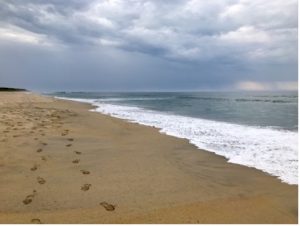
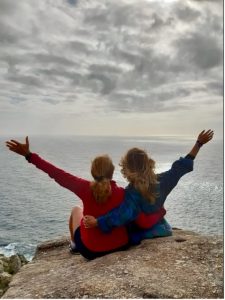
The human experience
The Camino is also family and community. We experienced first- hand how pilgrims bond in a special way, creating an instant comforting camaraderie of caring. Our nurturing and supportive friends were inextricably woven into our Camino experiences. We always looked out for each other and were so happy every time we encountered people we had previously met. We were all out of our comfort zone which made us more open and accepting of each other. This led us to show our emotions without shame or embarrassment and to feel those of others, without judgement. We cried, we hugged, we laughed, we smiled. It was a testimony of pilgrim love, acceptance and respect. Everyone has their own story.
Along with the many dear friends we made along the way, what was also very precious to us was the local people’s welcoming. In Portugal, at the albergue
we stayed at in Vila Nova de Anha, the young owner’s
mother, Flora, was so kind as to medicate the blisters on
our feet (even the pain is soothing, the blisters and the backache, it’s all worth it!). She does this every day for pilgrims when she gets home from her job as a nurse at the hospital.
In Spain, one day we went into a small chapel in Mouzos
Village, where we met Debee. She sang an Irish blessing
for us while playing her guitar; it was a true gift. She
and her husband, Alfonso, opened their home to us that
evening: Hope House Galicia, a caring place to emotionally connect and receive encouragement on
your personal journey. We will never forget such beautiful souls.
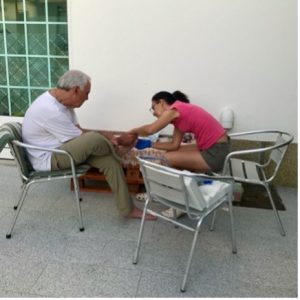

The Camino’s powerful lesson
We learned that you can get by with just the bare essentials; you don’t need much. We lived simply, with just the basics: eating, walking, taking in the surroundings, enduring pain from blisters and aching muscles and fatigue, following the Camino yellow and blue arrows, looking out for fellow pilgrims, finding a place to sleep, washing yourself and your clothes, drying them in any way you can, sleeping and then starting all over again each day, the same rituals and routines. We liked carrying our house on our back like a turtle with its shell. You can be so creative with what you have, and it is surprising how easy it becomes to let go of what you don’t have.
The Camino provides, it gives you extraordinary experiences along the way and precious memories to treasure forever and learn from. We are all different yet all the same. I am so grateful to have shared this experience with such a strong, positive and kind woman, my amazing Aunt Laura.
It is very rewarding to reach your objective physically, mentally, and spiritually. When you finish, you feel like you could hike all the way home. They say the Camino starts then… and I can’t wait to do it again!
I wish the world and everyday life were a bit more like the Camino, especially now, given the present challenges and hard times.
